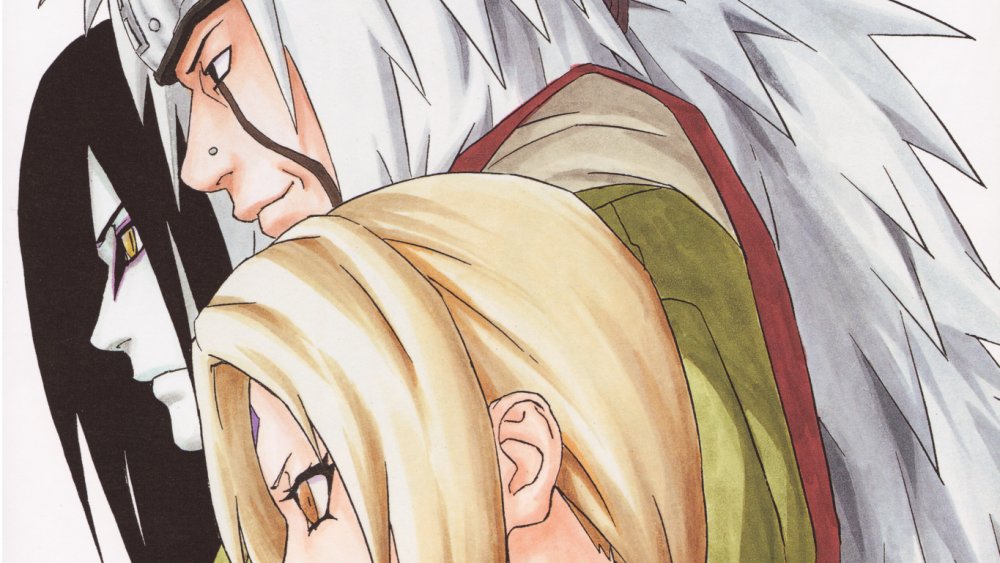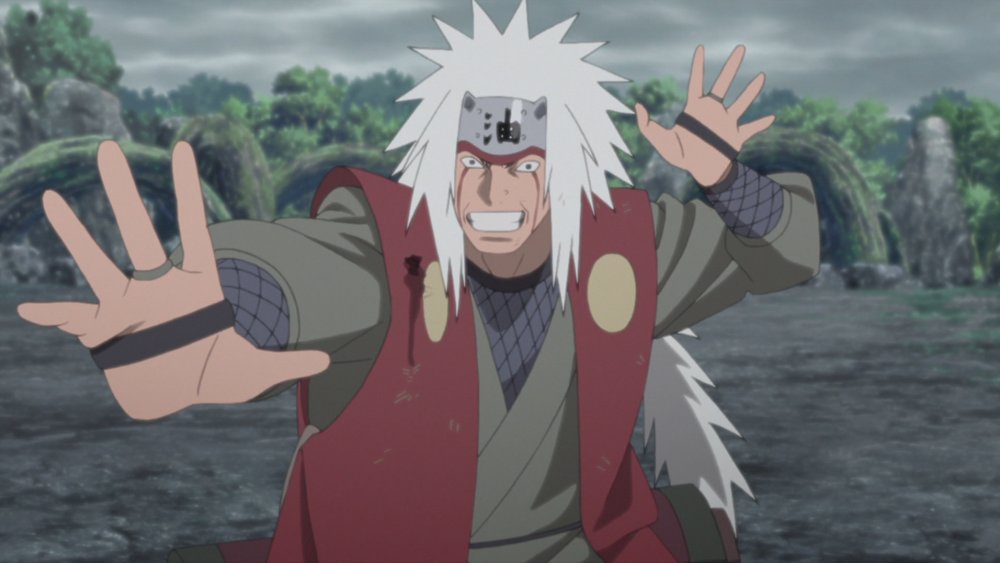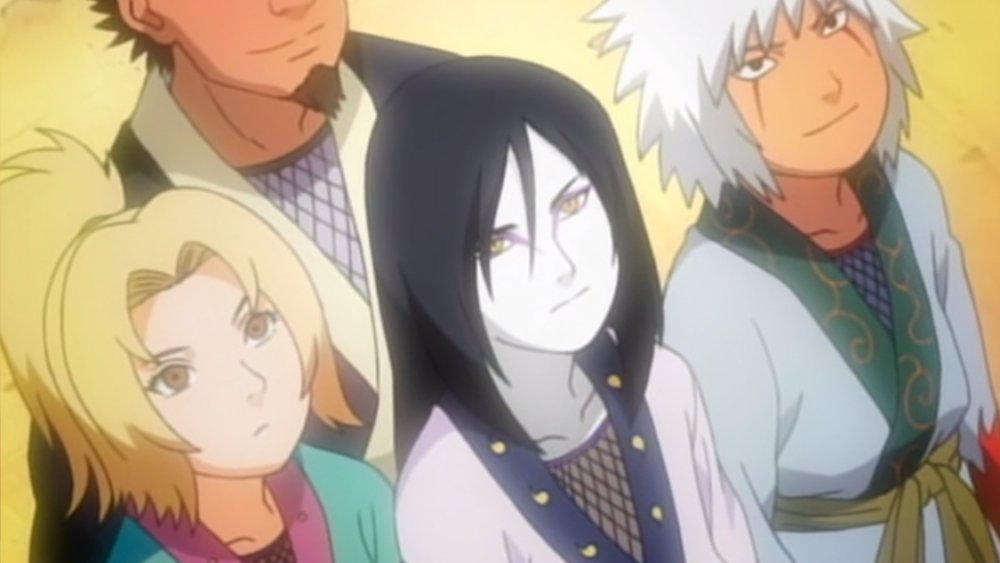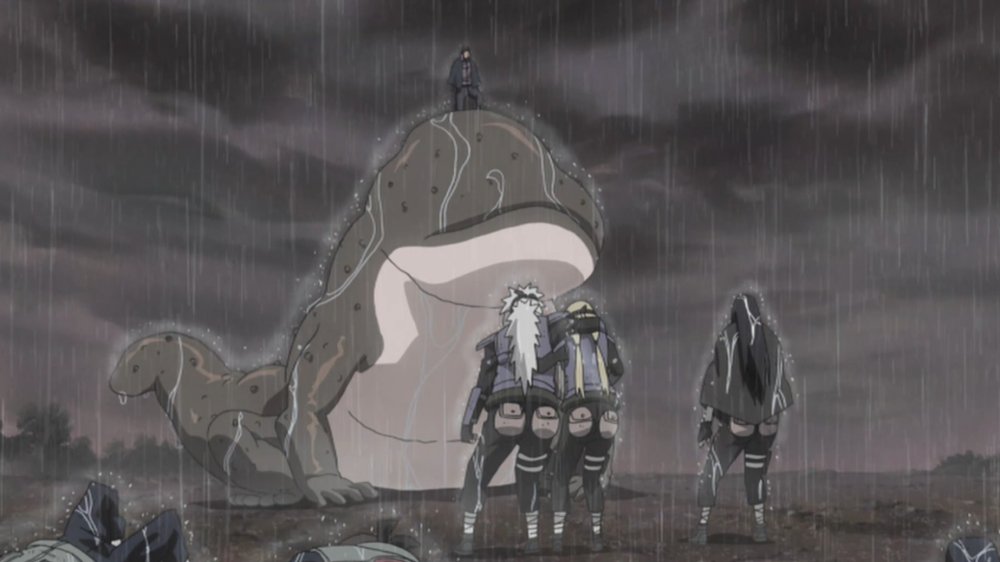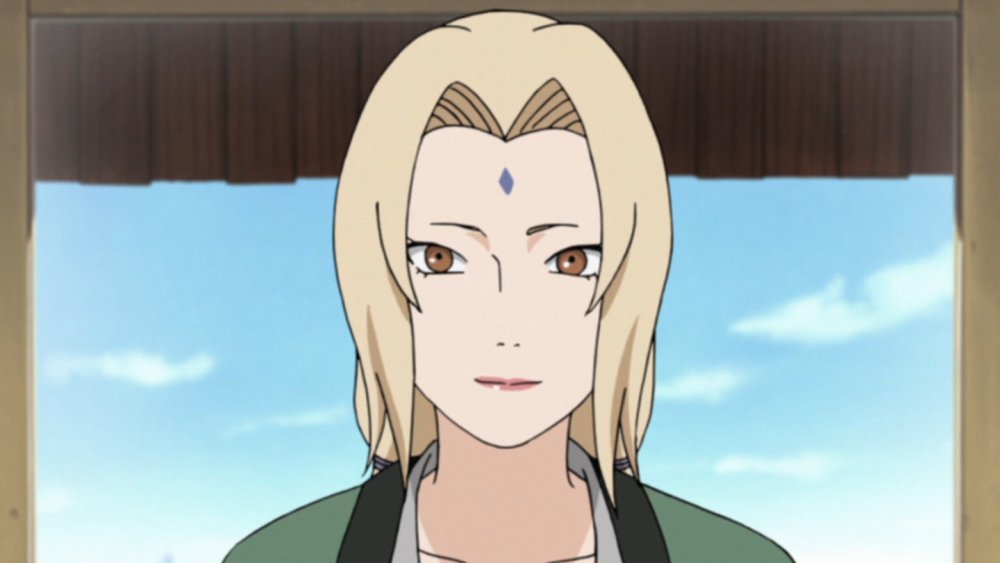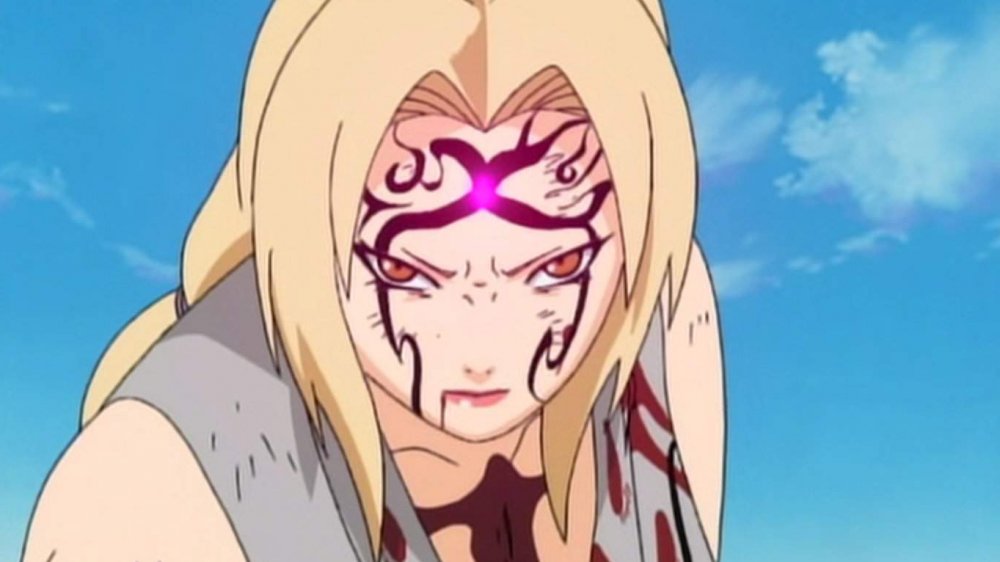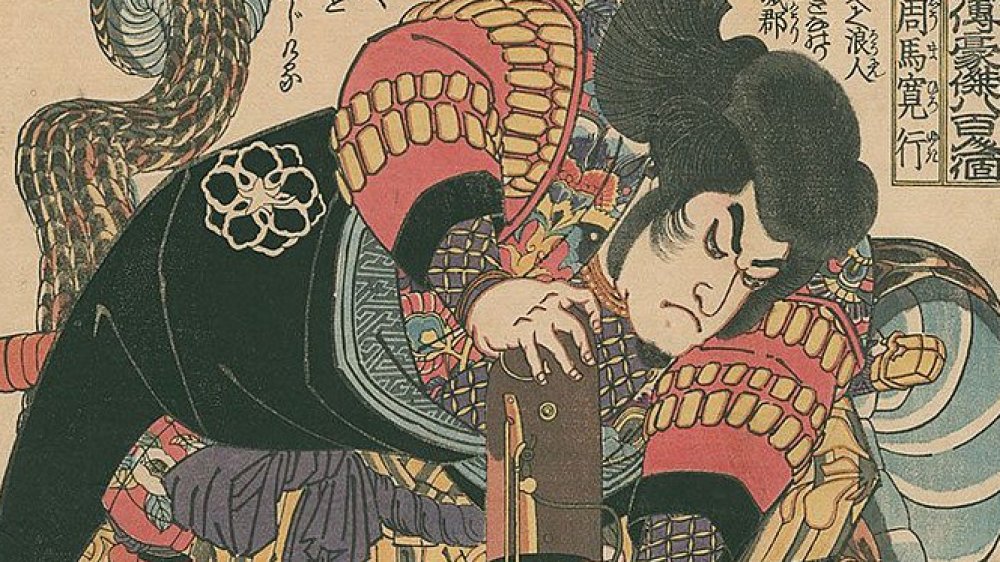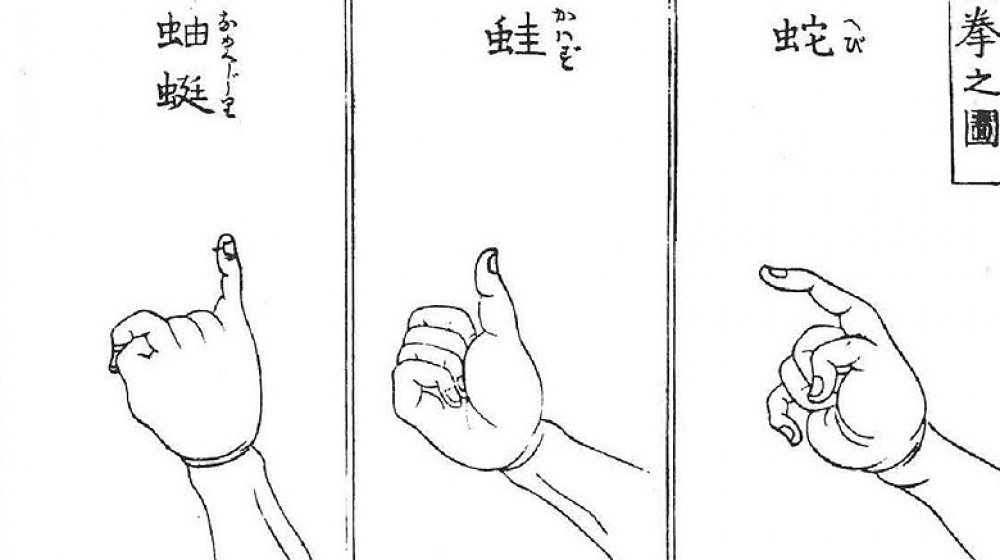The Untold Truth Of The Legendary Sannin From Naruto
We tend to think of history in distinct eras, despite the fact that the past doesn't actually work like that. At any given point, distinct civilizations are going through different stages of development, and mythical heroes push up against the modern day. Past bleeds into present, which becomes the future. Our fictional worlds reflect this blurriness with a clarity that can be hard to find in the real world. The Three Legendary Sannin of Naruto are a prime example.
A trio of renowned ninja, their actions gained them worldwide fame in a war that took place well before many of the series' protagonists were born. But they didn't fade away into the past — the Sannin become enormously influential parts of Naruto's world. Nor do their actions in the past cease to matter. If anything, Naruto is entirely about the rippling effects of history crashing into the present.
The story of these three iconic fighters is a complex one that winds around every part of the Naruto universe. This is the story of the three legendary Sannin, from their complicated pasts to the multifaceted presents.
Understanding the Sannin
The Legendary Sannin are the Audie Murphys of Naruto's ninja-based world. They are the best fighters of their generation, having trained under the Third Hokage of their home village of Konohagakure. Notably, they were brought together in the same way the three protagonists of the main Naruto series are: They were grouped together at the beginning of their training.
Jiraiya, Orochimaru and Tsunade were taught how to fight for their nation, the Land of Fire, by Hiruzen Sarutobi. They are all skilled fighters with incredible reserves of chakra. Their personalities mirror their younger counterparts, with Jiraiya taking on the goofy and carefree attitude of Naruto, Orochimaru exhibiting Sasuke's morose demeanor and general nihilism, and Tsunade being deeply protective and a skilled healer. While their status as national heroes opened up many powerful positions to them, they all spent their lives after the war well outside of state power, leaving their lives as powerful soldiers for the Land of Fire behind.
Rfits in the trio
The Legendary Sannin are nearly always referred to in the collective sense as an unbreakable triumvirate. The reality of the trio is far from that unified and powerful front, however. According to Tsunade, the Sannin argue constantly and any conversation between them is more of an unsettle-able three-way argument than the plotting of a well-trained military unit.
Tsunade describes their relationships to one another as a "three-way deadlock" and they act in ways that bear that out. Though they trained together in the academy and reunited as a military unit in the Second Shinobi War, they disbanded their group as soon as their academy days were over, and again when the conflict ended.
Following the war, the three fighters drifted apart. Jiraiya moved on to a life of writing books and training the younger generation. Orochimaru was shunned from society after it was discovered he was carrying out experiments on other fighters in the hopes of achieving eternal life. Tsunade was so disillusioned by the war, she dropped out of the world of ninjitsu entirely.
They were named by their enemy
The name Sannin was bestowed upon them somewhat begrudgingly, as it turns out. The first person to call the group by that name was Hanzo of the Salamander, fiendish leader of the village of Amegakure. He gifted them the moniker after they survived a devastating battle during the Second Shinobi War. Hanzo wiped out every other Konohagakure soldier who fought against him that day. When he realized that Jiraiya, Tsunade and Orochimaru had survived while everyone else around them perished, he dubbed them "Konoha's Legendary Sannin."
We don't need to tell you that the name stuck. Hanzo himself hung around for a long while after, and the name came right along with him. The Sannin would get theirs, however. Hanzo ultimately meets his end at the hands of Nagato, a trainee of Jiraiya's, out for vengeance after Hanzo ambushed him and his friends, resulting in the death of a comrade.
Possible hokages?
The status bestowed upon the three Sannin put them on the fast track to becoming well-respected leaders in Konoha. Jiraiya is ultimately uninterested in becoming the Hokage, the leader of the village recognized as the strongest ninja, preferring to focus on training younger ninjas and writing novels. Orochimaru deeply wants to control the village, but his experimentation on other shinobi and deep character flaws make him an ill-fitting choice for village leader.
Tsunade is also considered for the role of Hokage, but her extreme disinterest in matters of state and a recently developed fear of blood make the campaign a non-starter. She simply can't bear the idea of another war. Where many people would leverage their newfound fame into a more consequential role in their homeland, Tsunade nearly disappears. After a long period in the wilderness, Tsunade returns to political life as an older woman. She does ultimately end up taking the role of Hokage, after a meeting with Naruto breaks the spell of her own defeatism.
A biological connection
The three Sannin have very little in common. They are wildly different in temperament, levels of ambition and life goals. There's almost nothing that they can agree on, as their constant arguments and eventual paths highlight. Oddly enough, they do share one common trait: Their blood type.
This was revealed in one of the Naruto series' companion guidebooks — think of them as Shinobi Tiger Beat. They examine each character in the sprawling world of the comic and give a run-down of everything people would like to know (and a few things you wouldn't) from favorite foods to battle history. For example, these books reveal Tsunade's favorite drink is sake, and she loves to gamble. Jiraiya loves pickled garlic and writing, uh, adult novels. Those same guide books will clue you in on the fact that all three Sannin are blood type B, something very useful for the healer, Tsunade — if she wasn't scared of blood.
Legacy
Before the original series began, Jiraiya set the main conflict in motion by training the original members of the Akatsuki. This would come to backfire spectacularly, as Akatsuki leader Nagato ultimately kills Jiraiya. Jiraiya does manage to send a message to Naruto that explains how Nagato could be defeated, however, before he dies.
Sasuke falls under the spell of an exiled Orochimaru, who spent his life after the war seeking out immortality. Sasuke trains under the skilled but morally compromised ninja, believing himself to be working to get stronger in order to defeat his brother Itachi. Ultimately, however, Orochimaru is training up Sasuke so that he may one day possess his body and use his inborn abilities to further his goals of immortality.
Tsunade trains Sakura, both heightening the young ninja's natural healing abilities and teaching her how to level devastating attacks. At this point in the series, Sakura is self-conscious about the fact that both Naruto and Sasuke can dole out a lot more damage than she can. Tsunade teaches Sakura how to expel chakra from her fists and turns her into a gifted fighter as well as a renowned healer.
Names from real-world legends
The three Sannin get their names from real-world Japanese myths. Specifically, their names are pulled directly from the folktale Jiraiya Goketsu Monogatari. The story follows a ninja who is a talented shapeshifter as he takes on an evil snake spirit that is wreaking havoc. Characteristics of the three Sannin, as well as their summoning jutsus, are lifted from this tale.
Orochimaru is the name of the student who has been corrupted and turned into a giant snake. Accordingly, the Naruto character's summoning jutsu is a snake and his storyline follows a similar path: The ambitious student who is ultimately corrupted. Jiraiya in the folktale is a master of "toad magic," and Naruto's Jiraiya's summoning jutsu brings forth toads. Tsunade in the story is a practitioner of "slug magic." As you might guess, in Naruto, she summons slugs with her summoning jutsu. Also as in the original story, Jiraiya of Naruto is in love with Tsunade.
Rock, paper, scissors
To Japanese viewers of the show, the summons the three Sannin use underline the fact that they are always at loggerheads. While slug, toad and snake doesn't mean much to an American audience, Japanese fans easily notice that their summons are mirrors of a local variant of rock, paper, scissors known as jan-ken, one of many sansukumi-ken games.
In this take on the game, the snake is afraid of the slug, the slug is afraid of the frog, and the frog is afraid of the snake. Other variants exist, for example, one featuring a supernatural fox, the head of a village, and a hunter. The first known iteration of the game dates back to the Han dynasty in China between 200 BC and 200 AD. It came to Japan shortly thereafter as sansukumi-ken (the slug, toad and frog variant specifically) and eventually made its way to the West as rock, paper, scissors in the 19th century.
That the Sannin can call upon these animals shows that they are always in conflict with one another, and that they are all evenly matched.
